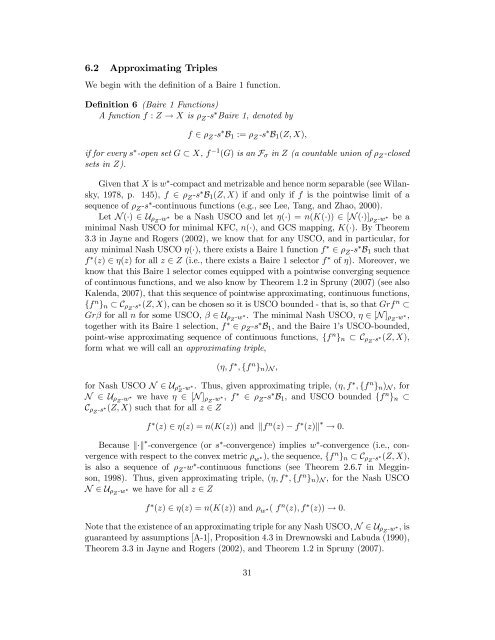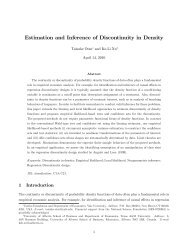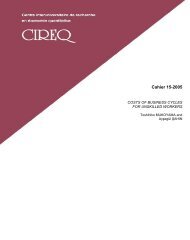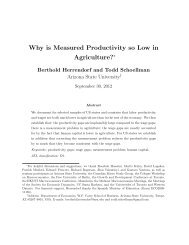Externalities, Nonconvexities, and Fixed Points
Externalities, Nonconvexities, and Fixed Points
Externalities, Nonconvexities, and Fixed Points
Create successful ePaper yourself
Turn your PDF publications into a flip-book with our unique Google optimized e-Paper software.
6.2 Approximating TriplesWebeginwiththedefinition of a Baire 1 function.Definition 6 (Baire 1 Functions)Afunctionf : Z → X is ρ Z -s ∗ Baire 1, denoted byf ∈ ρ Z -s ∗ B 1 := ρ Z -s ∗ B 1 (Z, X),if for every s ∗ -open set G ⊂ X, f −1 (G) is an F σ in Z (a countable union of ρ Z -closedsets in Z).Given that X is w ∗ -compact <strong>and</strong> metrizable <strong>and</strong> hence norm separable (see Wilansky,1978, p. 145), f ∈ ρ Z -s ∗ B 1 (Z, X) if <strong>and</strong> only if f is the pointwise limit of asequence of ρ Z -s ∗ -continuous functions (e.g., see Lee, Tang, <strong>and</strong> Zhao, 2000).Let N (·) ∈ U ρZ -w ∗ be a Nash USCO <strong>and</strong> let η(·) =n(K(·)) ∈ [N (·)] ρ Z -w ∗ be aminimal Nash USCO for minimal KFC, n(·), <strong>and</strong> GCS mapping, K(·). ByTheorem3.3 in Jayne <strong>and</strong> Rogers (2002), we know that for any USCO, <strong>and</strong> in particular, forany minimal Nash USCO η(·), there exists a Baire 1 function f ∗ ∈ ρ Z -s ∗ B 1 such thatf ∗ (z) ∈ η(z) for all z ∈ Z (i.e., there exists a Baire 1 selector f ∗ of η). Moreover, weknow that this Baire 1 selector comes equipped with a pointwise converging sequenceof continuous functions, <strong>and</strong> we also know by Theorem 1.2 in Spruny (2007) (see alsoKalenda, 2007), that this sequence of pointwise approximating, continuous functions,{f n } n ⊂ C ρZ -s ∗(Z, X), can be chosen so it is USCO bounded - that is, so that Grf n ⊂Grβ for all n for some USCO, β ∈ U ρZ -w ∗. The minimal Nash USCO, η ∈ [N ] ρ Z -w ∗,together with its Baire 1 selection, f ∗ ∈ ρ Z -s ∗ B 1 , <strong>and</strong> the Baire 1’s USCO-bounded,point-wise approximating sequence of continuous functions, {f n } n ⊂ C ρZ -s∗(Z, X),form what we will call an approximating triple,(η,f ∗ , {f n } n ) N ,for Nash USCO N ∈ U ρ∗Z-w ∗. Thus, given approximating triple, (η,f∗ , {f n } n ) N ,forN ∈ U ρZ -w ∗ we have η ∈ [N ] ρ Z -w ∗, f ∗ ∈ ρ Z -s ∗ B 1 , <strong>and</strong> USCO bounded {f n } n ⊂∗(Z, X) such that for all z ∈ ZC ρZ -sf ∗ (z) ∈ η(z) =n(K(z)) <strong>and</strong> kf n (z) − f ∗ (z)k ∗ → 0.Because k·k ∗ -convergence (or s ∗ -convergence) implies w ∗ -convergence (i.e., convergencewith respect to the convex metric ρ w ∗), the sequence, {f n } n ⊂ C ρZ -s∗(Z, X),is also a sequence of ρ Z -w ∗ -continuous functions (see Theorem 2.6.7 in Megginson,1998). Thus, given approximating triple, (η,f ∗ , {f n } n ) N , for the Nash USCON ∈ U ρZ -w ∗ we have for all z ∈ Zf ∗ (z) ∈ η(z) =n(K(z)) <strong>and</strong> ρ w ∗( f n (z),f ∗ (z)) → 0.Note that the existence of an approximating triple for any Nash USCO, N ∈ U ρZ -w ∗,isguaranteed by assumptions [A-1], Proposition 4.3 in Drewnowski <strong>and</strong> Labuda (1990),Theorem 3.3 in Jayne <strong>and</strong> Rogers (2002), <strong>and</strong> Theorem 1.2 in Spruny (2007).31






